 The Tripolis mint of late third century Rome
The Tripolis mint of late third century RomeA list of all the coin types. An educational resource for collectors.
by Warren Esty
 The Tripolis mint of late third century Rome
The Tripolis mint of late third century Rome
A list of all the coin types. An educational resource for collectors.
by Warren Esty
A Tripolis coin of Diocletian with the distinctive "TR" mintmark in the field. Poorly engraved portraits are also a characteristic of the Tripolis mint.
(Skip down to the coins of Aurelian, Tacitus, Probus, Carus, Numerian, Carinus, Diocletian, or Maximian.)
Tripolis minted Roman coins, radiate "aureliani" (a.k.a. "antoniniani") and a few aurei, for a limited time during the reigns from Aurelian (AD 270-275) through Diocletian and Maximian (284-305). The mint was probably closed about 286. The Tripolis coins of Aurelian and Tacitus are not clearly mintmarked, but after Tacitus, Tripolis coins are marked "TR" in the reverse field. The mint city is normally identified with the Tripolis south of Antioch (lower right on the map). However, one scholar, F. Redö, argued the coins were minted at a different Tripolis (in Phrygia, in Asia Minor, center left on his map reproduced here) and argues that it was also the city of the enigmatic mint with mintmark "SPQR" in the exergue under Gallienus and Claudius II. (Most scholars now think the SPQR mint is Cyzicus.)
I think the mint is the Tripolis south of Antioch. I list coins according to RIC which first assigns coins to Tripolis under Aurelian. This site lists only aureliani, not aurei.
What's new? Feb. 25, 2025: A link to a DIVO CARO with eagle with the eagle's head right instead of left.
May, 2018. DIVO CARO AVG/CONSECRATIO with eagle.
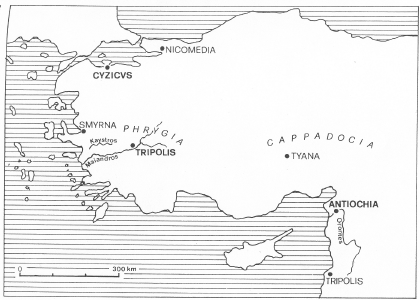
References
Roman Imperial Coinage, volume V, part I, by Percy H. Webb, 1927 and volume V, part II, by Percy H. Webb, 1933. Spink & Son, London. (RIC)
D'Aurelien a Florien (270-276 apres J.-C.) by Sylviane Estiot (Estiot), Biliotheque National de France, Monnaies de l'Empire Romain, XII.1. The new (2004) standard reference for coins of Aurelian, Tacitus, and Florian. 2004 in two volumes.
Aureliano, volume II.1, Ripostiglio della Venera Nuovo Catalogo Illustrato, by Sylvane Estiot (Est) . 1995.
"The history of the SPQR mint," by F. Redö, in Mitteilungen des Archäolgischen Instituts der Ungarnischen Akademie der Wissenschaften 12/13 1982/1983, Budapest, pages 85-111.
"Analyses de Series Atypiques" by J. P. Callu, Cl. Brenot, and J. N. Barrandon, in Numismatica e Antichita Classiche, VIII, 1979, pages 241-254.
"The alloy of the 'XI' coins of Tacitus" by Warren Esty, Nancy Equall, and Richard Smith, in Numismatic Chronicle, 1993, pages 97-226.
Roman Imperial Coins in the Hunter Coin Cabinet, volume IV, by Anne Robertson, 19878, Oxford University Press. (Hunter)
Ripostiglio della Venera Nuovo Catalogo Illustrato, Aureliano, volume II/1, by Sylviane Estiot, 1995.
Key to the Format of each entry:
Obverse legend
| Reverse legend (obverse legend variety, if applicable) |
RIC number and page. Estiot BN reference (for Aurelian and Tacitus) Estiot Aureliano reference (for Aurelian) Hunter reference Other references |
Reverse type description (as given in RIC) mintmark, including field marks |
IMAGE of obverse and reverse |
| PROVIDENTIA DEORVM (with PF in obverse legend) |
Not in RIC. Estiot emission 1, Nov.-Dec. 275, page 258. Plate 64, 1838-1840 |
Emperor standing r holding scepter, receiving globe from Jupiter stg. l, holding scepter * over dot over KA, or * over KA |
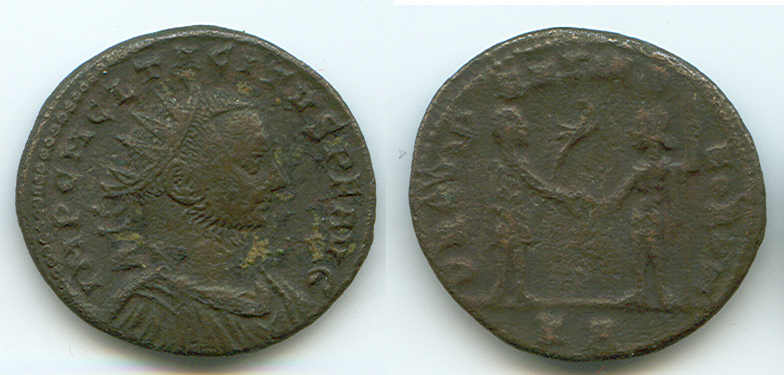 |
| PROVIDENTIA DEORVM (same type as above but without PF, as are the following issues) |
Not in RIC. Estiot emission 1, Nov.-Dec. 275, page 258. Plate 64, 1839-1841 |
Emperor standing r holding scepter, receiving globe from Jupiter stg. l, holding scepter * over dot over KA, or * over KA |
 |
| CLEMENTIA TEMP | RIC#213, p.348 KA variety Estiot emission 2 Jan.- June 276 Plate 64, 1845 |
Emperor stg r holding scepter, receiving globe from Jupiter stg. l, holding scepter * over KA |
no image [See Diocletian 328 below for the reverse type.] |
| CLEMENTIA TEMP | RIC#213, p.348 IA variety Estiot emission 2 Jan.- June 276 Plate 64, 1848 |
Emperor stg r holding scepter, receiving globe from Jupiter stg. l, holding scepter * over IA |
no image, same type as previous. |
| CLEMENTIA TEMP | RIC#214 KA variety Estiot emission 2 Jan.- June 276 Plate 64, 1842-1844 |
Mars stg. or walking l, holding olive branch and spear and shield. "R" * in field left, KA in exergue |
 |
| CLEMENTIA TEMP | RIC#214 IA variety Plate X.154 "double anoninianus" Estiot, emission 2, Jan.- June 276 Plate 64, 1846-1847 |
Mars stg. or walking l, holding olive branch and spear and shield. "R" * in field left, IA in exergue IA coins are slightly larger in diameter than KA coins. K is 20 in Greek] and "10 parts copper and 1 of silver" [I is 10 in Greek]. Therefore the very rare "IA" coins probably indicate a short-lived and ill-fated coin reform. They certainly would have been regarded as different by the issuer and users, and deserve two different reference numbers. |
 |
|
VIRTVS AVGG |
#128, p.150 Hunter -- |
Emperor standing right, holding sceptre, receiving globe from Jupiter (or Carinus) standing left, holding sceptre. * in upper field, TR in lower field, XXI in exergue. |
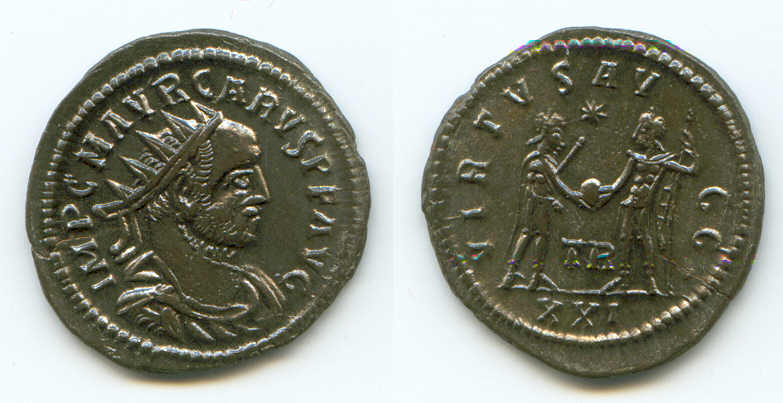 |
| DIVO CARO AVG /CONSECRATIO |
#129, p. 150 Hunter -- |
eagle standing and looking left (There is an unlisted example with the eagle's head looking right) T to left, R to right XXI in exergue |
 |
| DIVO CARO AVG /CONSECRATIO |
not in RIC (seen in trade) |
altar, with garland, T to left, R to right XXI in exergue. |
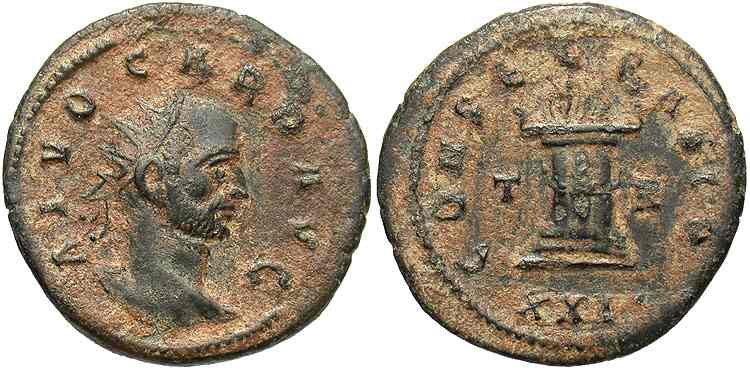 |
|
VIRTVS AVGG |
#209, p.165 as Caesar |
Prince standing right, holding sceptre and receiving globe from Jupiter (or Carus) standing left, holding sceptre. [See #329 below for this reverse, but with obverse as Augustus.] |
 . . |
| VICTORIA AVG IMP M AVR CARINVS PF AVG |
#328, p.179 as Augustus |
Emperor standing left, holding sceptre and receiving wreath from Victory, standing right, holding palm | no image [See Diocletian 330 for the reverse type] |
|
VIRTVS AVGG |
#329, p. 179 as Augustus |
Emperor standing right, holding sceptre (sometimes eagle-tipped), receiving Victory (with or without globe) from Jupiter (or Carus) standing left, holding sceptre. This example has the globe, but not Victory on it. * in upper field, TR in lower field, XXI in exergue. |
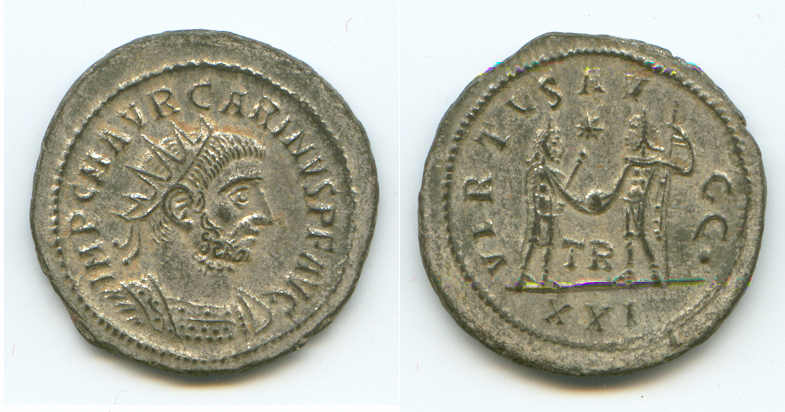 |
| IOV ET HERCV CONSER AVGG [note: two G's] |
#327 p.257 |
Jupiter standing right holding globe and sceptre, facing Hercules standing left, holding Victory, club, as lion's skin XXI with palm left to right in exergue |
 |
| IOVI CONSERVATORI AVG [note: one "G"] |
#328 Hunter 75, plate 54.75 (Fine) |
Emperor standing right, holding sceptre, receiving Victory on glove from Jupiter standing left, holding sceptre. XXI in exergue |
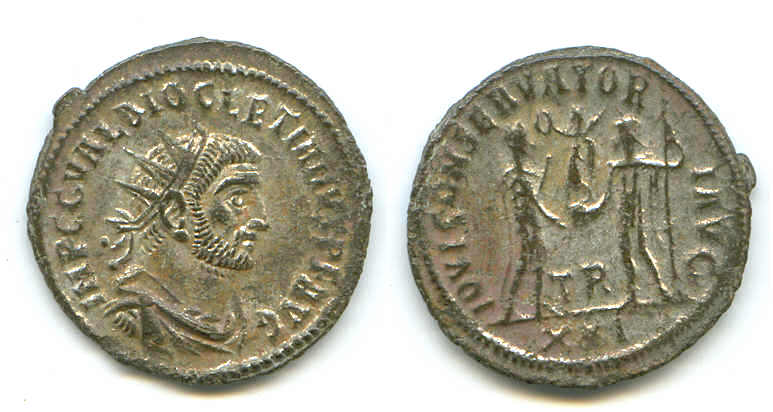 |
| IOVI CONSERVATORI AVGG [note: two G's] |
#329 |
Emperor standing right, holding sceptre, receiving Victory on glove from Jupiter standing left, holding sceptre. <palm>XXI in exergue [The object held by the emperor is described by RIC as a "sceptre", but this may be the same object described by RIC and below as a "parazonium" (a short sword worn at the waist) under Maximian #626.] |
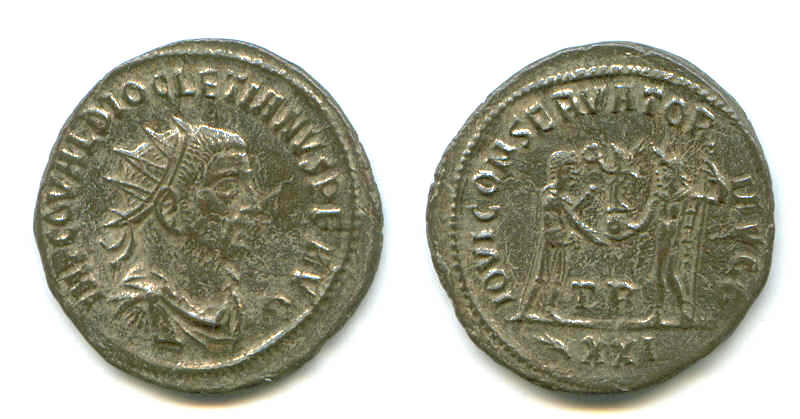 |
| IOVI CONSERVATORI AVG [note: one "G"] |
#330 | Victory right holding palm, presenting wreath to emperor holding globe and scepter XXI in exergue |
 |
| IOVI CONSERVATORI AVGG | #331 | Victory r holding palm, presenting wreath to emp holding globe and scepter XXI<palm> in exergue |
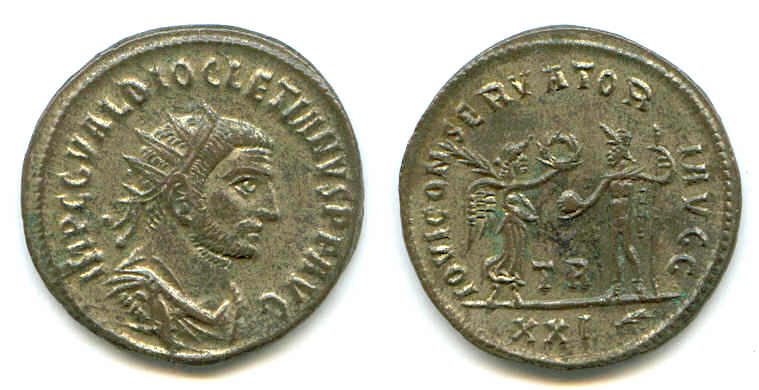 |
| VICTORIA AVG | #332 | Victory r holding palm, presenting wreath to emp holding globe and scepter XXI in exergue |
no image [See the next type for the reverse type.] |
| VICTORIA AVG [same as above except PF omitted in the obverse legend] |
#333 | Victory r holding palm, presenting wreath to emp holding globe and scepter XXI in exergue |
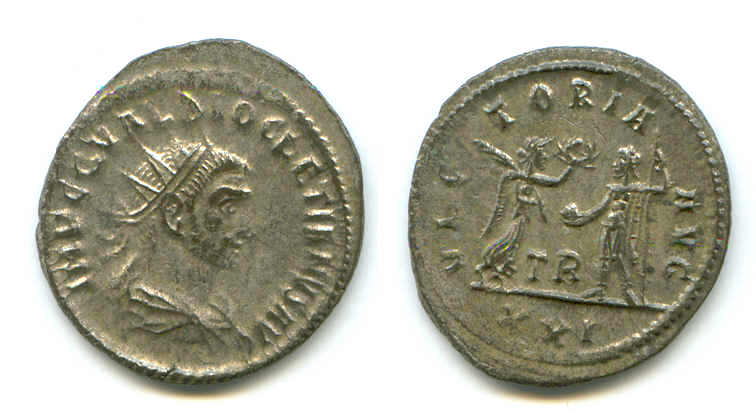 |
| IOV ET HERCV CONSER AVGG (as Diocletian 327) |
#624, p.294 Hunter 62, 63, plate 56.63 (EF, sl. o/c) |
Emp stg r holding globe and scepter, facing Hercules stg l holding Victory, club and lion's skin XXI<palm> in exergue or <palm>XXI |
 |
| IOVI CONSERVATORI AVGG (as Diocletian 331) |
#625, p.295 | Victory walking right holding palm, presenting wreath to Jupiter left holding globe and scepter XXI<palm> in exergue |
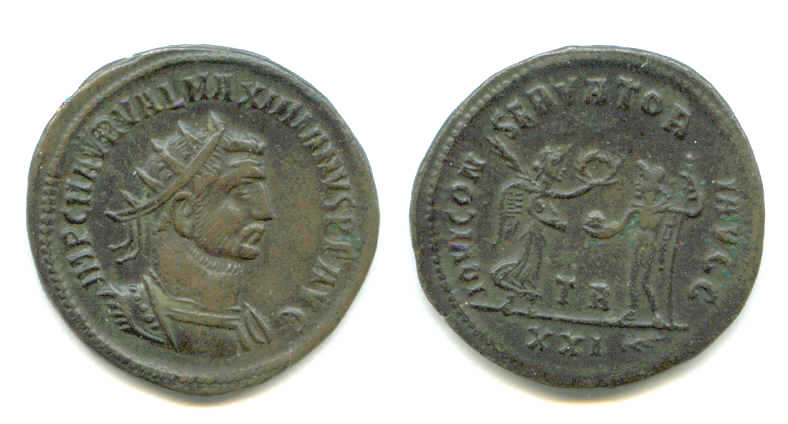 |
| IOVI CONSERVATORI AVGG (as Diocletian 329) |
#626. p.295 | Emperor standing right, holding parazonium, receiving Victory on globe from Jupiter. XXI or <palm>XXI or XXI<palm> in exergue. [This may be the same type as Diocletian 329, with the "sceptre" there called a "parazonium" (a short sword worn at the waist) here.] |
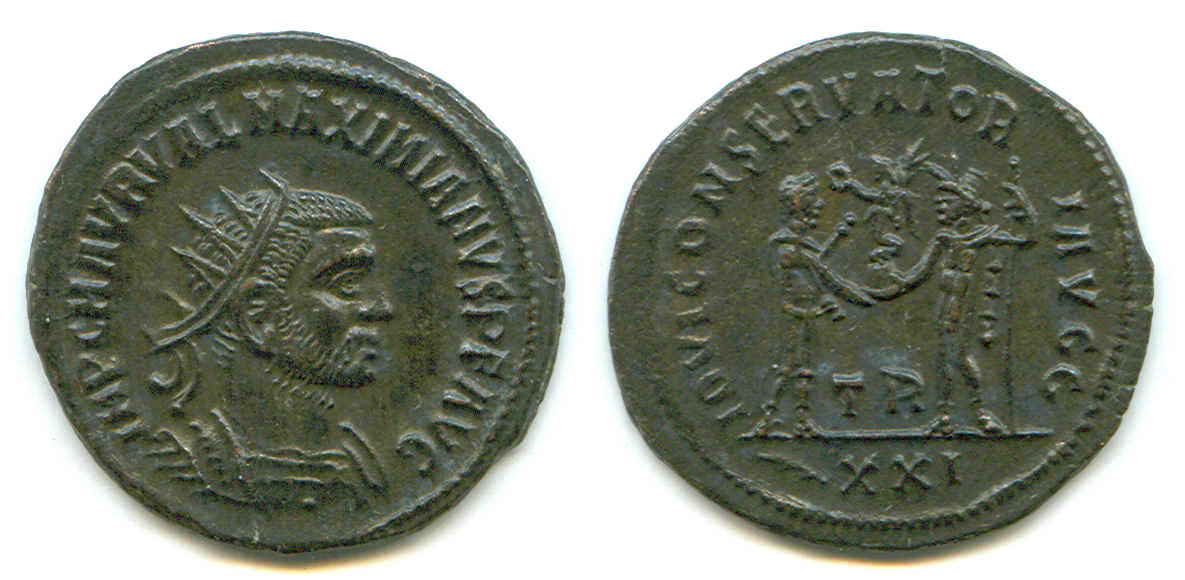 |

Return to the main index page.